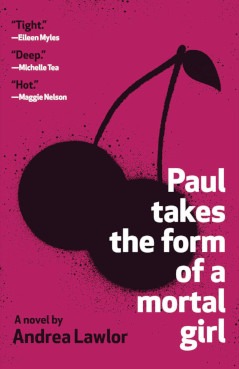
Andrea Lawlor’s wildly inventive novel Paul Takes the Form of a Mortal Girl (Vintage. $16.95. www.andrealawlor.com) is a Niagara Falls of gender fluidity. Paul Polydoris, the protagonist in this frothy rush of queer theory and magic realism, is a shapeshifter, able to transmogrify his body parts and carnal appetites as the spirit moves him (Lawlor opts to use male pronouns for the character). He can shrink his penis and grow C-cup breasts with a concentrated stare, or massage away his adam’s apple on a moment’s notice: “It was like that TV show, Manimal, only that guy couldn’t control himself”). Paul speeds from tryst to tryst and city to city in a restless early-1990s identity quest, submerging himself in a panoply of queer communities, from the Michigan Womyn’s Music Festival to ACT UP in New Yorkto the back room of the San Francisco Eagle. Lawlor’s greatest accomplishment is rendering Paul with a consistent psyche: whether his genitals are male or female, whether he’s having straight or gay or lesbian sex, there’s never a Jekyll and Hyde aspect to his character. We don’t perceive Paul as switching from one persona to another; we feel him flowing among aspects of a single self. While vivid sex scenes and jaunty prose keep the pages turning, Lawlor’s plotting is loose and picaresque. Like the varieties of sexual and gender expression it explores—and like the books of William S. Burroughs, which it evokes—”Paul” is perhaps best dipped in and out of, rather than rushed through in hope of resolution. Originally published by small independent Rebel Press in 2017, the very fact that this book has been acquired and reissued for the mass market by a division of Penguin/Random House suggests that cultural attitudes about nonbinary sexuality may be as capable of transformation as Paul is.
